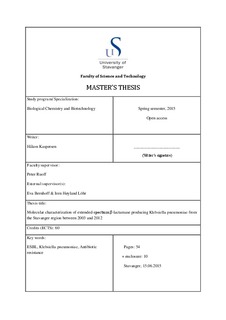| dc.description.abstract | Klebsiella pneumoniae is a Gram-negative rod in the Enterobacteriaceae family, known to cause both community- and hospital-acquired infections, especially in immunocompromised patients. In the hospital setting, K. pneumoniae strains resistant to antibiotics are increasingly reported to cause infections and outbreaks. K. pneumoniae is commonly found to produce extended-spectrum β-lactamases (ESBLs), which inactivate the most important antibiotics: penicillins, third generation cephalosporins and monobactams. The most widespread ESBL enzyme among Enterobacteriaceae today is CTX-M-15, which is encoded and spread between strains by plasmids.
In this project, all (n = 49) ESBLA- producing K. pneumoniae isolates isolated from clinical samples at Stavanger University Hospital between 2003 and 2012 were characterized at a molecular level. Species identification and antibiotic resistance profile was confirmed by mass spectrometry and the Vitek 2 system, respectively. ESBLA-encoding genes were identified by PCR and gene sequencing, and clonal relatedness was investigated by pulsed field gel electrophoresis (PFGE) and multilocus sequence typing (MLST). Plasmids were identified and characterized by S1-PFGE, PCR-based replicon typing and Southern blot hybridization with blaCTX-M, blaSHV and IncFIIK probes.
All isolates were confirmed ESBLA - producing K. pneumoniae. Identified ESBLA encoding genes were typed as blaCTX-M-15 (n = 20), blaCTX-M-3 (n = 1), blaSHV-2 (n = 1), blaSHV-2A (n = 3), blaSHV-5 (n = 13), and blaSHV-12 (n = 5). The blaCTX-M-15 positive isolates were mainly clonally unrelated, and a common plasmid encoding blaCTX-M-15 could not be identified among these isolates. Two blaCTX-M-15 positive isolates were found to be clonally related to a strain which caused a neonatal intensive care unit outbreak at Stavanger University Hospital in 2008 – 2009. Twelve blaSHV-5 positive isolates were found to be closely related by PFGE and were typed as sequence type (ST) 29 by MLST. A ~230 kbp plasmid was found to bear blaSHV-5 in all blaSHV-5 positive ST29 isolates.
The most prevalent ESBLA-encoding genes among clinical K. pneumoniae isolates from the Stavanger region were blaCTX-M-15 and blaSHV-5. blaSHV-5 positive ST29 isolates have caused sporadic infections between 2003 and 2012, and may represent an endemic clone in the Stavanger region and hospital setting. In contrast, the blaCTX-M positive isolates were associated with diverse clones and plasmids. | nb_NO |
